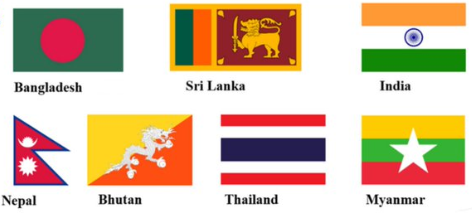BIMSTEC Charter Comes into Effect: A Milestone in Regional Cooperation (GS Paper 2, IR)

Background:
- The Bay of Bengal Initiative for Multi-Sectoral Technical and Economic Cooperation (BIMSTEC) saw a historic moment as its inaugural charter came into force, paving the way for new members and observers to join.
- Initially signed in 2022 during the fifth BIMSTEC summit held virtually in Colombo, Sri Lanka, the charter required ratification from all member countries, a milestone achieved in April 2024.
About BIMSTEC:
- Established in 1997 with the Bangkok Declaration, BIMSTEC comprises seven member countries: Bangladesh, Bhutan, Sri Lanka, Nepal, Thailand, Myanmar, and India.
- With its permanent secretariat in Dhaka, Bangladesh, BIMSTEC represents a significant portion of the world population (22%) and boasts a combined GDP of approximately $3.6 trillion.
Key Provisions of the Charter:
- The charter provides a legal and institutional framework for cooperation among member countries, granting BIMSTEC a legal personality and facilitating the admission of new members and observers.
- Notable aspects include decision-making by consensus, criteria for membership focusing on geographical contiguity or trade dependence on the Bay of Bengal, biennial leaders' summits, rotational chairmanship, and authority for the ministerial meeting to establish additional criteria as needed.
BIMSTEC and SAARC:
- The emergence of BIMSTEC gained momentum following the 2016 Uri attack, wherein India rallied SAARC nations to boycott the summit planned in Pakistan.
- While SAARC and BIMSTEC share geographic overlap, they serve distinct purposes.
- SAARC is regional, whereas BIMSTEC is inter-regional, bridging South Asia and ASEAN. BIMSTEC, unencumbered by India-Pakistan tensions, offers a cooperative platform conducive to regional development.
Comparison with SAARC:
- SAARC, founded in 1985 with its secretariat in Kathmandu, Nepal, aims to foster economic and social development through intra-regional cooperation among eight member states.
- However, unlike SAARC, which grapples with India-Pakistan animosity, BIMSTEC provides a more harmonious environment for collaboration.
Way Forward:
- The implementation of the BIMSTEC Charter underscores member states' commitment to regional cooperation across various sectors, including security, connectivity, trade, agriculture, environment, science and technology, and people-to-people exchanges.
- It signifies a significant step towards forging agreements with other nations and regional entities, heralding a new era of cooperation and development in the Bay of Bengal region.
Conclusion
- The BIMSTEC Charter stands as a testament to the collective resolve of member states to foster inclusive development and strengthen regional ties, offering promising opportunities for collaboration and growth in the years ahead.


